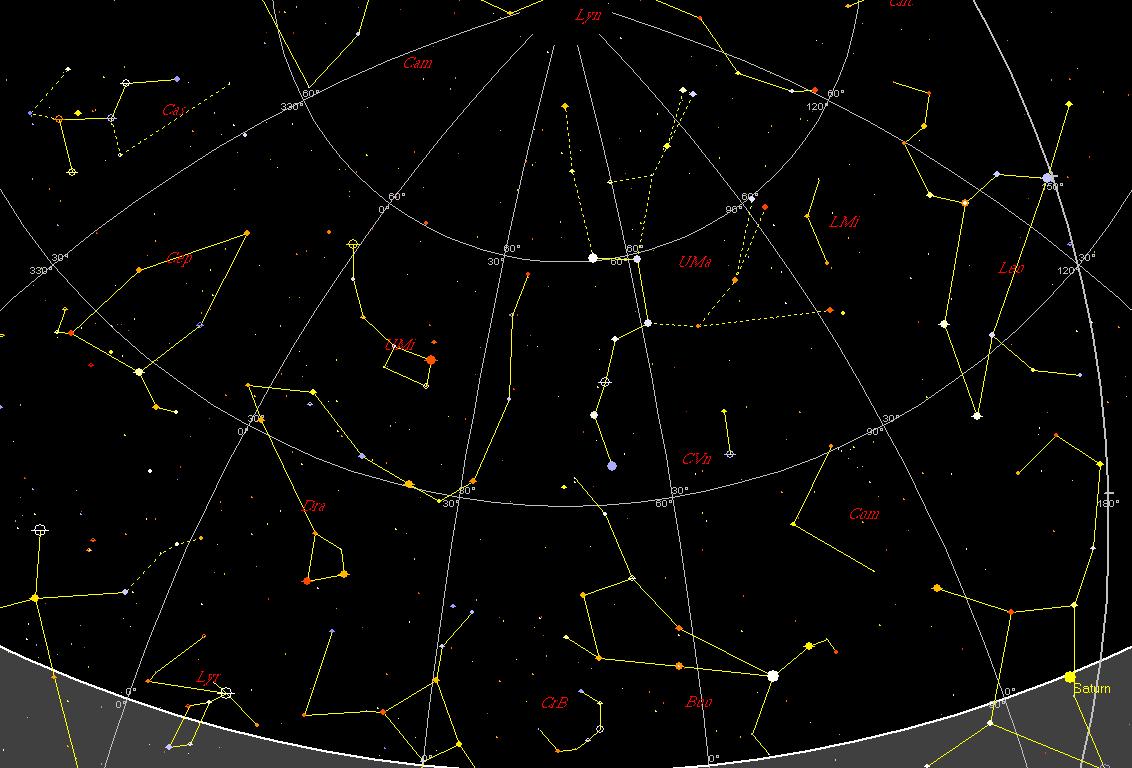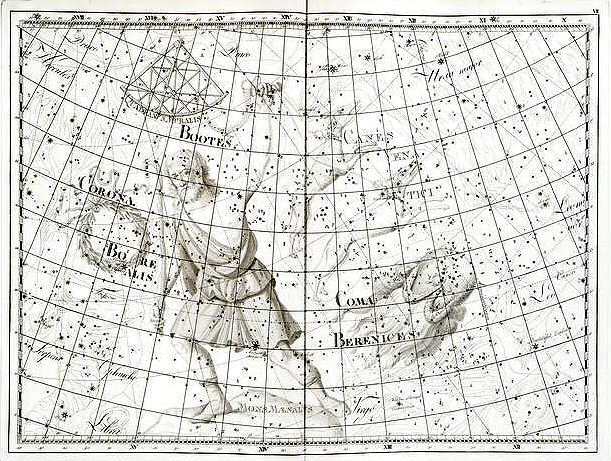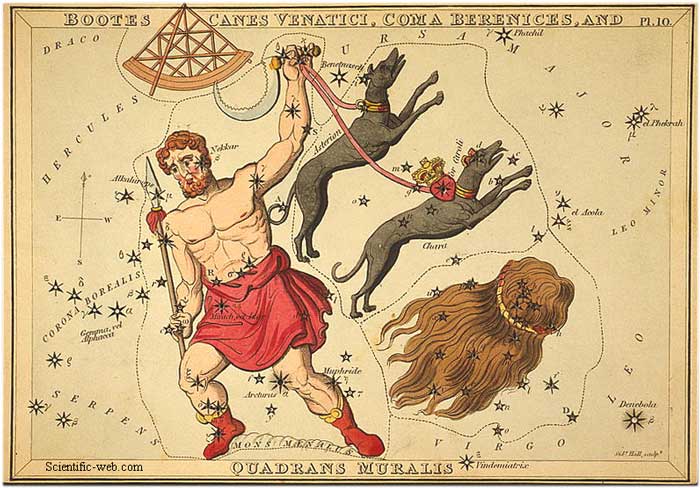
The Northeast sky Jan 4 at 1:00 a.m. PST. Look between Ursa Major and Minor, and the bright star Arcturus in Boötes for the location of Quadrans Muralis on the Boötes-Draco border
Most meteor showers radiate from a recognizable constellation like Leo’s Leonids, Gemini’s Geminids and Orion’s Orionids. What’s up with the January Quadrantids? Where do you find their constellation? In Quadrans Muralis, a demoted constellation.
The first 60+ Roman constellations didn’t cover the sky south of the equator, so over the years, astronomers took up the task and filled in the empty spaces with new constellations, including some in the northern sky.
The International Astronomical Union divided up the sky into official constellations in 1930. 88 constellations remained, but over 30 constellations didn’t make the cut. Among those demoted was Quadrans Muralis, the location of January’s brilliant, but brief Quadrantid meteor shower. Apis, the bee, Felis, the cat, and Solarium the sundial were other constellations demoted into obsoleteness. One ancient constellation, Argo Navis, didn’t survive, either. It’s the only one of the 48 constellations listed by 2nd century astronomer Ptolemy no longer officially recognized as a constellation. Like other pieces of large real estate, it was subdivided into smaller segments in the 17th century, and those constellations — Carina the Keel, Vela the Sails, and Puppis the Poop Deck — survived demotion.
There were good reasons to define and standardize the constellation list, even if it meant losing some historic or whimsical constellations. One reason, according to the IAU was “to aid in the naming of new variable stars, which brighten and fade rather than shine steadily. Such stars are named for the constellation in which they reside, so it is important to agree where one constellation ends and the next begins.”
Quadrans Muralis was added to the constellations by Joseph J. de Lalande in 1795, to commemorate the quadrant he used to observe and measure stellar positions. The quadrant was an instrument very similar to today’s sextant. A few years later, in the early 1800′s a meteor shower was discovered to radiate from this constellation, and the meteor shower was named for the constellation.
Created from stars found to the north of Boötes, the herdsmen; Quadrans Muralis can be found in a rich area of the northern sky filled with pretty constellations. The big and little dippers (the most recognizable parts of Ursa Major and Ursa Minor) are the most familiar sights but you’ll also find the Northern Crown, Corona Borealis, Boötes and his two hunting dogs Asterion and Chara in Canes Venatici, and Coma Berenices, the hair of Bernice. Take a tour of the area through binoculars on January 3rd before midnight while waiting for the radiant to rise.
Update for 2012 for Southern California meteor observers: “The radiant rises at 1:00 am local time and the moon sets at 3:00 am. The predicted peak (2:30 am Eastern 11:30 PST (07:30 UT January 4, 2011).
The Quadrantids (QUA) or January Bootids are active from January 1st through the 10th. A sharp maximum is predicted to occur near 0730 Universal Time on the 4th. This corresponds to 02:30 EST and 23:30 PST (January 3rd). This is good timing for viewers located in eastern North America as the radiant will rising above the northeastern horizon. It would even be better if the maximum were a bit later as the radiant would be located higher in the sky, producing more activity.
Rates will depend on the exact time of maximum and whether the moon is still above the horizon. Assuming the 0730 UT timing is correct, the further one is located in North America, the better. Eastern observers may be able to see 60-75 Quadrantids per hour. If your skies are very clear and dark, allowing you to see faint meteors, your rates could top 100 per hour. Observers located in the western portions of North American will have lower rates but will also have the opportunity to see Quadrantid “earthgrazers”. Earthgrazers are meteors that skim the upper portion of the atmosphere therefore lasting much longer than normal and producing long trails in the sky. These meteors can only be seen when the radiant lies close to the horizon. As the radiant rises, the meteor paths
will become shorter with shorter durations. Observers in the northern hemisphere outside of North America can expect to see a maximum of 25 Quadrantids per hour between moon set and dawn.
At maximum the radiant is located at 15:21 (230) +49. This position lies in a barren region of extreme northern Bootes, ten degrees northeast of the fourth magnitude star Beta Bootis. At 42 km/sec. the Quadrantids produce meteors of medium velocity. During exceptional activity some Quadrantid fireballs may be witnessed. Courtesy Bob Lundsford posting on the MeteorObs Yahoo Group.
Streaming video & a visibility map for tonight’s (January 3-4, 2012) Quadrantids meteor shower
My What’s Up video for January 2011 (not 2012): The January 3-4 Quadrantid Meteor Shower



I thought that Argo Navis does live on in a way, broken down into smaller constellations: Carina (keel), Vela (sail), Puppis (poop or stern), and Pyxis (compass).
I found a really great article on Argo Navis here:
http://www.astro.wisc.edu/~dolan/constellations/extra/ArgoNavis.html
It looks like Argo Navis also included modern constellations Volans (flying fish) and Columba (dove).
Yes it was cut up into four related constellations, but my article is about Quadrans Muralis, not all the other unfortunate demotees and their progeny.
On second thought, I updated the post to include the detail about subdividing Argo Navis this morning.
[...] More about the Quadrantids and their namesake constellation, Quadrans Muralis [...]
[...] January Quadrantids and a demoted constellation [...]
[...] More Demoted Constellations [...]
[...] January 3 Quadrantids will be washed out by the beautiful last quarter moon. Have a look, and enjoy this pretty moon view between hunts for the Quadrantids. [...]